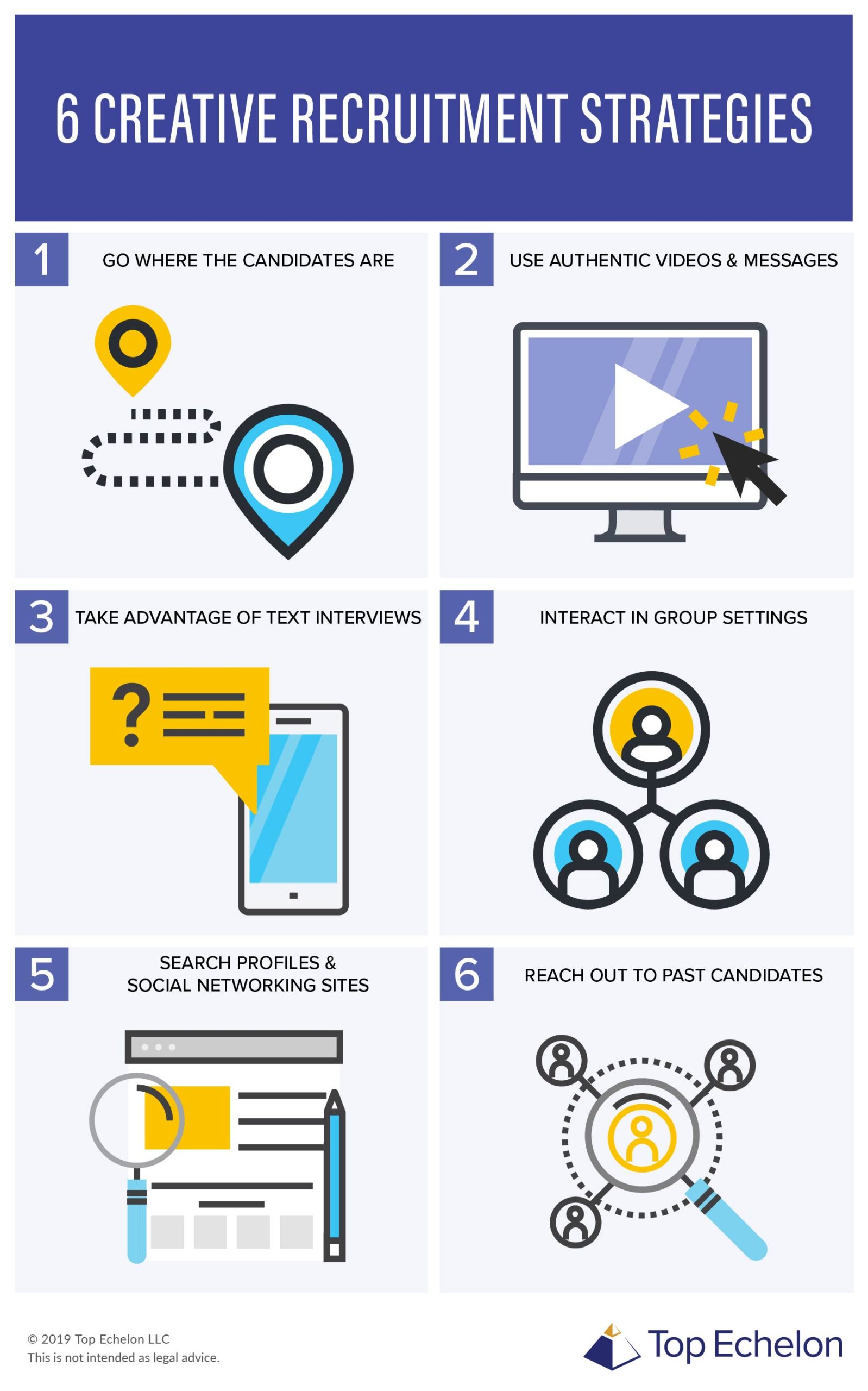If you want a competitive advantage against other recruiters, your strategies must be innovative. However, sometimes using the same recruiting strategy time and again can get stale. Take your search to the next level by using creative recruitment strategies.
6 Creative recruitment strategies
Consider using the six creative recruitment techniques below.
1. Go where the candidates are
Traditional recruitment methods often rely on posting job openings on online job boards or waiting for candidates to come to them. However, in today’s competitive job market, top talent may not be actively seeking new opportunities. As a result, recruiters are exploring unconventional avenues to proactively engage with potential candidates.
One key aspect of this creative recruitment strategy is understanding the target audience and identifying the platforms and spaces where they are most active. This could involve attending industry-specific events, conferences, or meetups where professionals in a particular field gather. By physically being present in these spaces, recruiters can establish a direct and personal connection with potential candidates.
Social media has become an invaluable tool in the recruiter’s arsenal. Platforms like LinkedIn, Twitter, and even niche forums and groups allow recruiters to go beyond traditional job postings. They can actively participate in discussions, share industry insights, and build relationships with professionals who may not be actively job hunting but are open to new opportunities.
Furthermore, embracing technology and utilizing data analytics can enhance the effectiveness of this strategy. Recruiters can leverage data to identify trends, understand the preferences of specific demographics, and tailor their approach accordingly. Machine learning algorithms can help predict where potential candidates are likely to be found, enabling recruiters to allocate resources more efficiently.
Employing a multi-channel approach is another crucial aspect of this strategy. Instead of relying solely on one avenue, recruiters can diversify their efforts by combining online and offline methods. For example, hosting virtual networking events or webinars can complement in-person interactions, reaching a broader audience and accommodating those who may not be able to attend physical events.
Building a strong employer brand is integral to the success of this recruitment strategy. Job candidates are more likely to be attracted to organizations with a positive and engaging presence. Recruiters can leverage content marketing to showcase the company culture, values, and opportunities for growth. This not only attracts potential candidates but also serves as a powerful tool for retaining existing talent.
The creative recruitment strategy of going where the job candidates are requires adaptability and a willingness to explore new avenues. Recruiters must stay informed about industry trends, emerging technologies, and changes in candidate behavior. By staying ahead of the curve, they can position themselves as thought leaders and influencers within their respective fields.
2. Use authentic videos and messages
Authentic videos serve as a powerful tool for recruiters to showcase the human side of an organization. By capturing genuine moments within the workplace, such as team collaborations, company events, and employee testimonials, recruiters can provide candidates with an insider’s view of the company culture. These videos go beyond the polished image presented in written job descriptions, allowing candidates to see the real people, dynamics, and atmosphere within the organization. Authenticity resonates with candidates, fostering a sense of transparency and trust in the recruitment process.
One effective use of authentic videos is in crafting personalized messages to potential candidates. Instead of relying solely on traditional job postings, recruiters can create short video messages that speak directly to the candidate. These personalized videos can highlight specific aspects of the candidate’s profile, express genuine interest in their skills, and provide insights into why the organization would be an ideal fit for them. This personalized approach adds a human touch to recruitment, making candidates feel valued and appreciated.
Social media platforms, particularly those emphasizing visual content such as LinkedIn and Instagram, offer an ideal space for sharing authentic videos. Recruiters can leverage these platforms to showcase the company’s culture and values, reaching a broader audience and attracting passive candidates who may not be actively seeking new opportunities. Engaging visuals and authentic narratives on social media create a compelling brand story that goes beyond traditional recruitment methods.
The use of authentic videos is particularly effective in conveying the company’s unique selling points. Whether it’s the collaborative work environment, professional development opportunities, or a commitment to diversity and inclusion, videos allow recruiters to vividly communicate these aspects. A well-crafted video can evoke emotions and leave a lasting impression, making it more likely for candidates to remember and consider the organization when making career decisions.
Additionally, incorporating video interviews into the recruitment process enhances the candidate experience. Instead of relying solely on written communication, video interviews allow candidates to showcase their personality, communication skills, and cultural fit in a more dynamic manner. This two-way interaction not only helps recruiters assess candidates more comprehensively but also allows candidates to gain a better understanding of the company culture and team dynamics.
To successfully implement this creative recruitment strategy, it’s essential for recruiters to invest in quality video production, ensuring that the content aligns with the organization’s brand and values. Additionally, maintaining authenticity is paramount; overly scripted or staged videos can undermine the genuine connection that authentic videos aim to establish.
3. Take advantage of text interviews
Text interviews involve conducting initial interview rounds through written communication platforms, such as email, messaging apps, or specialized interview platforms. This strategy offers several advantages that contribute to its growing popularity among recruiters.
One key benefit is the flexibility text interviews provide to both recruiters and candidates. In traditional face-to-face or video interviews, scheduling conflicts can be a significant challenge. Text interviews, on the other hand, allow candidates to respond at their convenience, reducing time constraints and making the process more accommodating for individuals with busy schedules or those in different time zones.
Moreover, text interviews can be an effective tool for assessing a candidate’s communication skills and written expression. In many roles, effective written communication is crucial, and text interviews provide recruiters with an opportunity to evaluate this aspect early in the hiring process. Candidates can articulate their thoughts, respond to questions, and showcase their writing abilities, providing recruiters with valuable insights into their communication proficiency.
The asynchronous nature of text interviews also allows recruiters to reach a broader pool of candidates. Traditional interviews often require candidates to take time off work or travel, limiting the talent pool to those available for in-person or live video interviews. Text interviews break down these barriers, enabling recruiters to engage with candidates who might not have been accessible through traditional methods.
Additionally, text interviews support a more inclusive hiring process. Candidates who may experience anxiety or discomfort in face-to-face or video interviews might find text interviews less intimidating. This inclusivity fosters a more diverse candidate pool, promoting equal opportunities for individuals with varying communication styles and preferences.
To maximize the effectiveness of text interviews, recruiters can incorporate technology tools designed for this purpose. AI-driven platforms can assist in automating parts of the interview process, such as screening questions or initial assessments, allowing recruiters to focus on more nuanced aspects of candidate evaluation.
However, it’s crucial to recognize the limitations of text interviews. They may not be suitable for assessing certain non-verbal cues or interpersonal skills that are better evaluated through face-to-face interactions. Therefore, integrating text interviews as part of a comprehensive recruitment strategy that includes other assessment methods is essential.
4. Interact in group settings
Group meetings, which can take the form of industry conferences, networking events, or professional meetups, offer recruiters an opportunity to engage with a diverse pool of professionals. These gatherings bring together individuals with similar interests, experiences, and expertise, creating an environment conducive to meaningful interactions. Recruiters can leverage these group settings to not only network with potential candidates but also to gain valuable insights into industry trends and emerging talent.
One key advantage of this strategy is the ability to observe candidates in action. In a group setting, individuals often exhibit their communication skills, leadership qualities, and ability to collaborate with others. Recruiters can assess how candidates present themselves, contribute to discussions, and navigate group dynamics – aspects that are challenging to gauge in a traditional one-on-one interview.
Active participation in group meetings allows recruiters to showcase their industry knowledge and establish themselves as thought leaders. By contributing to discussions, sharing insights, and offering guidance, recruiters can position themselves as valuable resources within their respective sectors. This not only enhances the recruiter’s personal brand but also attracts top talent who appreciate and seek out expertise in their field.
Additionally, group interactions foster relationship-building on a broader scale. Recruiters can connect with professionals at various stages of their careers, from entry-level talent to seasoned experts. Building relationships early on with emerging professionals may result in long-term partnerships, as these individuals progress in their careers. For seasoned professionals, recruiters can serve as trusted advisors, providing guidance on career advancements and opportunities.
To maximize the effectiveness of this strategy, recruiters should be strategic in choosing the right group meetings to attend. Industry-specific conferences, workshops, and networking events tailored to the recruiter’s focus area can yield the best results. Preparing for these events by researching attendees, understanding industry trends, and having a clear strategy for engagement is essential to make the most of these opportunities.
In the digital age, virtual group meetings and webinars have become prevalent. Recruiters can extend their reach by participating in online group discussions and leveraging virtual platforms. This allows recruiters to connect with professionals from around the world and access talent that may not be geographically accessible through traditional methods.
5. Search profiles and social networking sites
The first key aspect of this strategy involves leveraging social networking sites like LinkedIn, which is widely recognized as a valuable platform for professional networking. Recruiters can harness the power of LinkedIn’s extensive user base to identify and engage with potential candidates. By searching for specific skills, experiences, or job titles, recruiters can narrow down their focus and connect with individuals who align with the requirements of the job in question.
Additionally, social networking sites offer recruiters insights into candidates’ professional backgrounds, endorsements, and recommendations. This wealth of information provides recruiters with a more comprehensive understanding of a candidate’s capabilities and potential cultural fit within an organization. By reviewing endorsements and recommendations, recruiters can gauge the candidate’s skills and work ethic based on the endorsements of their peers and colleagues.
Beyond LinkedIn, platforms like Twitter and Facebook also offer valuable insights into candidates’ personalities, interests, and communication styles. While these platforms may not be as explicitly professional as LinkedIn, they provide recruiters with a more holistic view of a candidate’s online presence. This can be particularly beneficial for roles that require strong communication skills or a certain level of online engagement.
The strategy of searching profiles on social networking sites also enables recruiters to proactively reach out to passive candidates. Rather than waiting for candidates to apply for open positions, recruiters can identify individuals who may not be actively seeking new opportunities but possess the skills and qualifications sought by employers. This proactive approach can be a game-changer in securing top talent before they become actively engaged in the job market.
To enhance the effectiveness of this strategy, recruiters can use advanced search filters and Boolean operators to refine their searches. These tools allow recruiters to specify criteria such as location, industry, and experience level, ensuring that they identify the most relevant candidates for a given role. The ability to tailor searches in this manner saves time and resources, allowing recruiters to focus on building meaningful connections with potential candidates.
However, it is essential for recruiters to approach this strategy with a balance of professionalism and respect for candidates’ privacy. While social networking sites provide valuable information, recruiters must exercise discretion and adhere to ethical standards. Building a positive and respectful online presence is crucial for recruiters, as it contributes to their credibility and enhances the likelihood of candidates responding positively to outreach efforts.
6. Reach out to past candidates
Reaching out to past candidates offers several advantages for recruiters. Firstly, it taps into a known talent pool – individuals who have already expressed interest in the organization or role. These candidates may have been finalists for previous positions, narrowly missed out on an opportunity, or simply been strong contenders in the recruitment process. By revisiting these candidates, recruiters can save time and resources that would otherwise be spent on sourcing and evaluating new candidates.
Additionally, engaging with past candidates fosters a sense of familiarity and rapport. The initial interaction and evaluation have already taken place, allowing recruiters to build on the foundation established during the previous recruitment process. This familiarity can facilitate smoother communication and a quicker assessment of the candidate’s fit for a new role. Recruiters can leverage insights gained from past interactions, understanding the candidate’s strengths, areas for growth, and career aspirations.
Moreover, reaching out to past candidates aligns with the principles of relationship-building in recruitment. Establishing and maintaining positive relationships with candidates, even those who were not selected for previous positions, contributes to a strong employer brand. Candidates who feel respected and valued throughout the recruitment process, regardless of the outcome, are more likely to view the organization favorably and consider future opportunities.
To effectively implement this strategy, recruiters can use a targeted and personalized approach. Instead of sending generic messages, recruiters should tailor their communication to each candidate’s specific experience, skills, and preferences. Acknowledging the candidate’s past engagement with the organization and expressing genuine interest in their current career trajectory demonstrates a personalized and thoughtful approach.
Technology plays a crucial role in enabling recruiters to manage and leverage their relationships with past candidates. Applicant Tracking Systems (ATS) and Customer Relationship Management (CRM) tools can help recruiters track and organize candidate interactions, ensuring that outreach efforts are timely and relevant. These tools also allow recruiters to segment past candidates based on skills, experience, and preferences, enabling more targeted and effective communication.
It is important to note that when reaching out to past candidates, recruiters should be mindful of the candidate’s current situation and circumstances. Circumstances such as job satisfaction, location, and personal commitments may have changed since the last interaction. Therefore, recruiters should approach the conversation with a genuine interest in understanding the candidate’s current professional goals and challenges.









